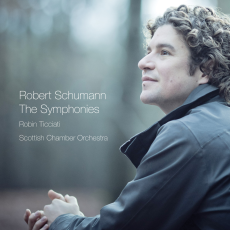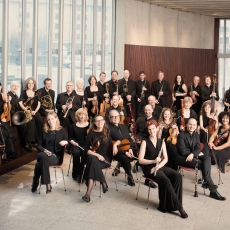Robin Ticciati & SCO - Schumann: The Symphonies - MusicWeb International
With complete sets from Simon Rattle and
from Yannick Nezet-Seguin, this is turning out to be quite the year for
Schumann symphonies. However, this new set from Robin Ticciati and the Scottish
Chamber Orchestra elbows those two aside and takes its place towards the very
top of the list of recommendations for these works, in this year or in any
other. Concerts of the complete set took pride of place in the SCO's programme
for autumn 2013: I found them very
impressive then,
and these CDs only serve to reinforce that impression of quality.
Robin Ticciati's
work with the Scottish Chamber Orchestra has been characterised by precise
attention to detail and real care for the colour of the sound. His great
achievement with the Schumann symphonies is that he peels back the Romantic
patina of the years and reminds us that these are symphonies from the early half of the nineteenth century. As
John Worthen's booklet notes point out, Beethoven had been dead for only
fourteen years by the time of Schumann's first symphony, and the heavy
encrusting that would befall much orchestral music was still a long way in the
future. Here, therefore, we hear Schumann's thoughts stripped of the weight
that would later lie on their shoulders and would, I suspect, be the source of the
accusation that Schumann was a poor orchestrator. With forces of this size and
skill, that allegation simply evaporates. Not a moment sounds unbalanced or out
of sync. Instead Ticciati and his musicians have found a way of presenting
Schumann's symphonic world with openness, brightness and superb clarity.
As a part of this,
Ticciati is light on his feet in his interpretations. Tempi are on the fast
side, and this means that the clarity of attack which characterises his
readings is realised to its very fullest potential. There is great precision on
display here, and the thwacks that end the Rhenish are only the most exciting example.
Listen, for example, to the brilliant trumpet triplets that punctuate the
scherzo sections of the Spring's
third movement or the light-as-a-feather articulation of the Fourth's finale.
He conducts with
the long view in mind and never plays things for a quick thrill. The fanfare
that opens the Spring symphony, for example, seems to grow
with each passing note, and the entire movement builds up to that fanfare's
majestic reappearance in the recapitulation. Then, however, Ticciati surprises
you with a beautifully tender rendition of the violin line in the coda, a
beautiful moment that I had never really noticed before. Similarly, the
introduction to No. 2 is pregnant with anticipation, spilling into a
rhythmically buoyant account of that first movement that bristles with quiet
energy. He also plays delicately with the rhythm at times, such as a tiny
holding back in the finale of the Spring symphony that adds bags of character.
The orchestra match
him with a carefully textured sound that is both light and flexible. The
strings play with minimal vibrato, thus giving them a thinner sound than in big
symphony orchestra recordings, but that also makes them more flexible and prone
to feats of great agility. Listen, for example, to the sprightly manner in
which they tackle the main theme of the Fourth's opening movement. They can be
used to great theatrical effect too, however, such as in the solemn slow
movement of the Rhenish where they sound even slightly
emaciated: this evocation of the cathedral brings to mind penitence and
mourning rather than mere scene-setting. There can be a slightly stringy
quality to the bass, but that helps to add to the flexibility and is a world
away from the gloopy heaviness that characterises so much of Karajan's
old-school Schumann set for DG. Sometimes they seem to hold the note just a
fraction of an inch beyond what you might expect, but this helps to further the
impression of a reading lovingly lingered over. Winds are pungent and tangy,
and the brass add well-judged colour without ever dominating too much.
The trombones, for
example, make a really distinctive difference when they come in at the slow
movements of the Spring and Rhenish symphonies, sounding, to my ears,
more spooky than majestic, and the horns sound repeatedly brilliant. In the Rhenish, for
example, they give thrilling clarion calls at the end of the first movement's
development, and their fanfares in the coda of the second movement put a
fantastic full stop on the action.
Linn have also done
a fantastic job with the recording, which is brilliantly clear and transparent,
opening up the internal textures of the playing in a way that sounds as though
they have been steam-cleaned. Everything is captured perfectly, and some
moments are thrillingly revelatory, such as the moment in the second movement
of the Rhenish where the second violins are given
the theme for the first time and the firsts rhapsodise around it. I've never
even noticed it before, and when a recording brings something to your attention
like that then it is a compliment indeed.
While it seems
unfair to isolate one performance for special praise, the Fourth, in my view,
is the best of all, and not just because it's my favourite one of the set;
Ticciati opts for the 1851 version, by the way. The opening bristles with
unresolved harmonic tension, helped by a string sound that is restrained
without sounding wiry, and then transitions organically - and very successfully
- into an energetic allegro. This symphony also plays best to Ticciati's skills
as a musical architect: the first movement's development is characterised by
urgent striving towards that moment where the finale's theme first appears and,
as in the development of No. 1, it is clearly that moment to which the entire
movement has been building. The slow movement then carries on that tension in a
more restrained way in its outer sections, and the central major section is
surprisingly beautiful, with a perfectly captured violin solo to boot. The
Scherzo bristles with energy, with a strangely beautiful Trio, and the transition
to the finale, more than in any other performance I've heard, put me in mind of
the equivalent passage in Beethoven's Fifth symphony. Ticciati handles it
expertly, building up a real sense of the portentous, with an exciting increase
in tempo just before the finale bursts onto the scene in a flash of light, and
I loved the way he grades the crescendo at the start of both the development
and the coda, leading to a marvellously positive ending.
This performance is
enough to blow out of the water any of the - now, surely, discredited - old
nonsense about Schumann's late works being the territory of a half-deranged
brain. This is great symphonic writing played by a great set of interpreters,
no mistake. In fact, when it's played like this, it was clearer to me than in
any other interpretation I've heard that Schumann's Fourth sits in the great
tradition of symphonies, like Beethoven's Fifth or Brahms' First, that move per aspera ad astra, and placing it within that context is as fine a tribute as
any to exactly what Ticciati is trying to do in this set; namely to place
Schumann in his context and to take him seriously on his own terms. With
beautiful packaging, well written notes and a free download copy thrown into
the deal, there is no reason to hesitate. This is a thrilling achievement.


